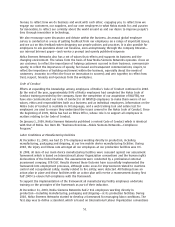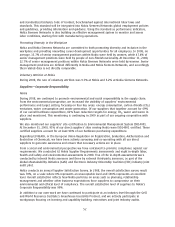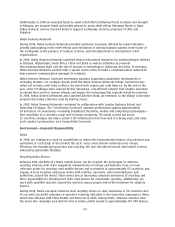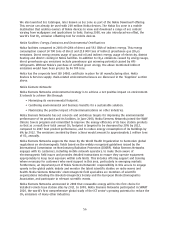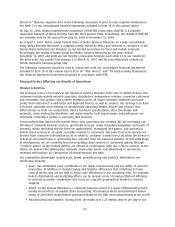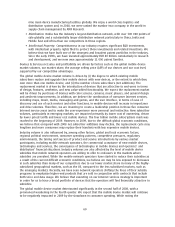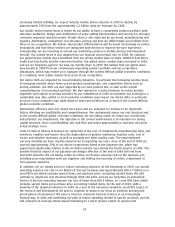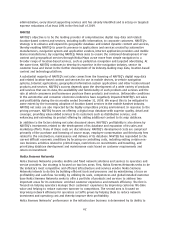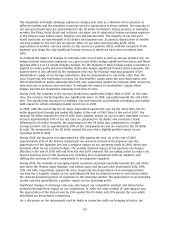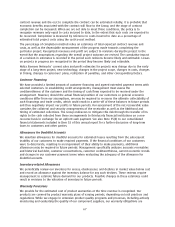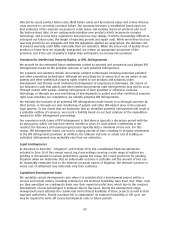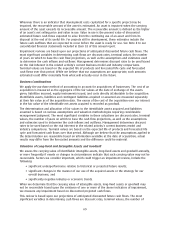Nokia 2008 Annual Report Download - page 61
Download and view the complete annual report
Please find page 61 of the 2008 Nokia annual report below. You can navigate through the pages in the report by either clicking on the pages listed below, or by using the keyword search tool below to find specific information within the annual report.nine main device manufacturing facilities globally. We enjoy a worldclass logistics and
distribution system and, in 2008, we were ranked the number two company in the world in
supply chain management by AMR Research.
•
Distribution:
Nokia has the industry’s largest distribution network, with over 300 000 points of
sale globally and a substantially larger distribution network particularly in China, India and
Middle East and Africa than our competitors in those regions.
•
Intellectual Property:
Competitiveness in our industry requires significant R&D investments,
with intellectual property rights filed to protect those investments and related inventions. We
believe that we have built one of the strongest and broadest patent portfolios in the industry.
Since the early 1990s, we have invested approximately EUR 40 billion cumulatively in research
and development, and we now own approximately 11 000 patent families.
Devices & Services net sales and profitability are driven by factors such as the global mobile device
market volumes, our market share, the average selling price (ASP) of our devices and our cost level,
supported by our competitive advantages.
The global mobile device market volume is driven by (i) the degree to which existing mobile
subscribers replace and upgrade their mobile devices with new devices, or the extent to which they
own more than one mobile device; and (ii) the number of new subscribers (net additions). The
replacement market is driven by the introduction of devices that are attractive to endusers in terms
of design, features, aesthetics, and new valueadded functionality. We expect the replacement market
will be driven by purchases of devices with color screens, cameras, music players, and general design
and aesthetic improvements. In addition, we believe the combination of consumer Internet services,
including maps, music, media, messaging and games, and the user interface, in terms of ease of
discovery and use of such services and other functions, in mobile devices will increase in importance
and drive volumes. Therefore, we are investing to create a leadership position in those five consumer
Internet service areas and to make the userexperience more personal and instinctive. New subscriber
volumes, particularly in emerging markets, are impacted primarily by lower cost of ownership, driven
by lower priced tariffs and lower cost mobile devices. The four billion mobile subscriptions mark was
reached in the beginning of 2009. However, in 2009, due to the difficult global economic conditions,
we believe that compared with 2008 net subscriber additions may decline, the replacement cycle may
lengthen and more consumers may replace their handsets with less expensive mobile devices.
Industry volume is also influenced by, among other factors, global and local economic factors,
regional political environment, consumer spending patterns, competitive pressures, regulatory
environments, the timing and success of product and service introductions by various market
participants, including mobile network operators, the commercial acceptance of new mobile devices,
technologies and services, the convergence of technologies in mobile devices and operators’ and
distributors’ financial situations. Industry volumes are also affected by the level of mobile device
subsidies that mobile network operators are willing to offer to endusers in the markets where
subsidies are prevalent. While the mobile network operators have started to reduce their subsidies as
a result of the current difficult economic conditions, we believe we may be less exposed to decreases
in such subsidies than many of our competitors due to our lower market share in many of the highly
subsidized geographical markets, such as the US, compared to the less subsidized markets, such as
the emerging markets. Recently, we have seen network operators shifting the focus of their subsidy
programs to emphasize higherend products that are sold in conjunction with contracts that include
both voice and data usage. We believe that executing on our Internet services strategy is important
in order for us to have a broad portfolio of devices that the operators will find financially attractive to
subsidize.
The global mobile device market deteriorated significantly in the second half of 2008, with a
pronounced weakening in the fourth quarter. We expect that the mobile device market will continue
to be negatively impacted in 2009 by the slowdown in consumer spending. While noting the
60



